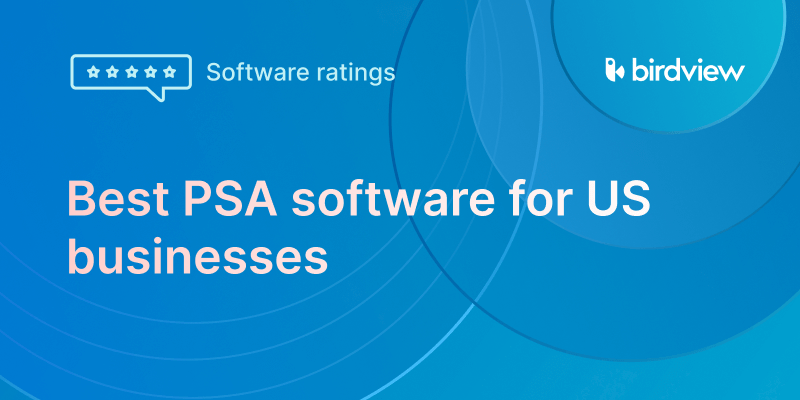Budgeting and financial management are the cornerstones of success in professional services projects. Unlike other industries, where products are tangible and costs can be more easily controlled, professional services operate in a landscape of intangibles. That includes time, expertise, and knowledge. This makes effective budgeting and financial management not just beneficial, but essential.
According to various sources, an average of 29% of projects fail due to inaccurate cost estimates. This underscores the importance of careful financial planning and management. A mismanaged budget can lead to project delays, cost overruns, and dissatisfied clients, all of which can harm a firm’s reputation and profitability.
What is budgeting and financial management in professional services?
Why budgeting and financial management matter in professional services
In professional services, where time and expertise are the core offerings, every hour spent on a project needs to be accounted for and translated into revenue. Without proper budgeting, it‘s easy for projects to run over costs, leading to reduced profitability or, in some cases, financial losses. Effective budgeting ensures that your team stays on track, client expectations are managed, and the project stays within financial constraints.
For example, imagine working on a large-scale IT consulting project. Without a clear budget, you could easily allocate too many resources to non-critical tasks, leaving little for the core deliverables. This would not only impact the project timeline but could also cause financial strain, especially if you‘re working within a fixed price or capped budget.
The most effective way to manage a professional services project budget is by using Professional Services Automation (PSA) software.
Related post: Top 10 PSA Software and Tools – 2024
Financial management strategies for professional services projects
1. Cost Control: Maintaining cost control is essential once a budget is in place. Constantly monitor expenses to ensure you‘re staying within budget. Project management software can be a lifesaver here. Platforms like Birdview PSA allow you to set financial thresholds and receive alerts when project costs are nearing these limits. This helps prevent budget overruns.
In my experience managing a marketing consulting project, early cost overruns were avoided by implementing a mid-project financial review. We discovered that we had allocated too many resources to the research phase, leaving limited resources for execution. Adjusting our resource allocation and tracking expenses closely brought the project back on track without compromising on quality.
2. Cash Flow Management: Maintaining a healthy cash flow is crucial for the survival of any business, particularly in professional services where projects may span several months or years. To manage cash flow effectively, it‘s essential to set clear billing milestones, ensuring that clients are invoiced promptly for work completed.
For example, when managing an engineering consulting project, we set monthly billing milestones based on project deliverables. This allowed us to maintain a steady cash inflow and avoid financial bottlenecks.
3. Financial Forecasting: Successful project managers don‘t just focus on current project finances; they also look ahead. Financial forecasting involves predicting future project costs, revenue, and profitability based on current performance. Regularly updating financial forecasts helps you identify any potential financial shortfalls early, allowing you to make adjustments before they become significant issues.
When managing an IT infrastructure upgrade for a large client, financial forecasting allowed me to anticipate potential cost increases due to rising vendor prices. By adjusting the budget early and communicating with the client, we were able to prevent any unpleasant surprises later in the project.
4. Resource Allocation: Resource allocation and financial management go hand in hand. The right resources–both in terms of people and tools–need to be assigned to the right tasks to optimize productivity and minimize costs. Over-allocating expensive senior resources to non-essential tasks can inflate project costs unnecessarily.
For example, in a legal services project, assigning senior partners to handle administrative tasks would be inefficient from a financial standpoint. Instead, allocating administrative work to junior associates allows senior resources to focus on high-value tasks, ensuring that the project stays within budget while maximizing profitability.
Key components of budgeting in professional services
1. Estimating Costs: The first step in effective budgeting is estimating costs accurately. This includes direct costs such as employee salaries, software tools, and equipment, as well as indirect costs like administrative overhead or unanticipated expenses. Use historical data from past projects to create more precise estimates. For example, if you‘ve previously managed a similar project, reviewing its financial reports will help you avoid underestimating or overestimating resources.
2. Revenue Projections: Knowing how much revenue a project is expected to generate is crucial. As a project manager, you should have a clear understanding of the billing structure–whether it‘s time-and-materials, fixed-price, or retainer-based. Use this information to set revenue targets and ensure that the project remains profitable. If you‘re working with a retainer-based contract for ongoing client services, ensure that your projected revenue aligns with the resources allocated to meet the client‘s needs.
3. Tracking Billable Hours: Professional services thrive on billable hours. Each hour worked by your team needs to be accounted for, whether you‘re billing by the hour or bundling those hours into a package for the client. Tools like Birdview PSA or other project management platforms allow project managers to track time in real-time, ensuring that every billable hour is captured and accounted for.
For instance, in a legal firm, where time-tracking is essential, failing to accurately monitor billable hours could result in lost revenue. This is where project management software can make a significant difference by automating time-tracking and reporting processes.
1. Fixed cost projects
As the name suggests, fixed-cost projects involve agreeing on a total price for the work before starting. This predetermined amount remains unchanged, regardless of time or resources used.
Example: A consulting firm might agree to implement a new software system for a client at a fixed price of $100,000, covering all aspects like planning, implementation, and testing. The client benefits from knowing the costs upfront, reducing financial uncertainty.
curate financial tracking.
Budgeting strategies for fixed cost projects
Budgeting for Fixed Cost Projects requires meticulous planning and risk management. The key to success lies in accurately estimating the costs upfront.
According to a report by McKinsey, 45% of large IT projects exceed their budgets by an average of 45%. This statistic highlights the importance of precision in budgeting for Fixed Cost Projects. In light of this, let‘s take a closer look at how to go about creating an accurate budget:
Define the scope clearly: The project scope must be detailed and agreed upon by all parties. Scope creep–when the project’s requirements grow without corresponding adjustments in budget or timeline–can be disastrous in Fixed Cost Projects.
Estimate costs accurately: Break down the project into smaller tasks and estimate the cost of each. Include direct costs (like labor and materials) and indirect costs (like overhead and risk buffers). Using historical data from similar projects can improve accuracy.
Factor in contingencies: Unexpected issues can arise in any project. A contingency reserve should be included in the budget to cover unforeseen costs.
Financial management considerations:
Successful financial management of fixed-cost projects requires careful tracking of project costs. Using project management tools like Birdview PSA ensures real-time monitoring of performance against the budget, helping to manage scope changes efficiently.
2. Time and material projects
Unlike fixed-cost projects, Time and Material (T&M) Projects are more flexible. In a T&M arrangement, the client pays for the actual time spent and materials used on the project.
This type of project is ideal when the scope is not well-defined or is expected to evolve. Thanks to its flexible nature, 39% of projects of this nature are popular in the professional services sector.
For instance, a law firm may charge a client based on the hours spent working on a legal case, plus any additional costs such as court fees or travel expenses. The client benefits from the flexibility of adjusting the project scope as needed, while the service provider ensures they are compensated for all work performed.
Rate cards and their role in time and materials projects
A rate card is a document that lists the hourly rates for different types of work or roles.
A simple example of a rate card would be a consulting firm charging $200 per hour for senior consultants, $150 per hour for junior consultants, and $100 per hour for administrative support.
This document is important in T&M projects for the following reasons:
Transparency: They provide the client with a clear understanding of the costs associated with different tasks or roles.
Budgeting: They allow both the client and the service provider to estimate the project‘s cost based on the expected hours and resources needed.
Flexibility: Rate cards can be adjusted if the project scope changes, ensuring that the service provider is compensated appropriately.

Budgeting techniques for time and materials projects
Budgeting for Time and Materials Projects involves estimating the time and materials required for the project and applying the rates from the rate card. While the budget may be less rigid than in fixed-cost projects, it‘s still essential to manage it effectively to avoid overspending.
However, budget-making on such projects can be challenging. The techniques below can help you through the process:
Estimate conservatively: Start with a high-level estimate and refine it as the project progresses. It‘s better to under-promise and over-deliver than the reverse.
Monitor hours closely: Use time-tracking tools to monitor the hours spent on the project. This helps prevent budget overruns and provides data for future project estimates.
Adjust as needed: As the project evolves, revisit the budget regularly. If more hours or materials are required, discuss the implications with the client and adjust the budget accordingly.
Financial management tips:
Managing a Time and Materials project requires real-time tracking of time and expenses. Birdview PSA integrates time-tracking and billing, helping to streamline financial management and prevent cost overruns.
![]()
3. Retainer projects in professional services
Retainer Projects are ongoing engagements where a client pays a fixed fee, typically monthly, for a specified amount of work or access to services. Retainers are common in fields like legal services, marketing, and IT support, where clients need continuous or on-call assistance.
For example, a digital marketing agency or a white label marketing services supplier might have a retainer agreement with a client to manage their social media accounts for $5,000 per month. This fee covers a set number of hours or deliverables, with any additional work billed separately.
Budgeting for retainer agreements
With a set of deliverables already defined, it can be easy to go above your budget and end up in losses during the life of the project. With this in mind, budgeting for Retainer Projects requires balancing the fixed monthly fee with the actual work performed.
The key is to set the retainer fee at a level that covers the cost of the expected work while allowing for profitability. Here are three steps you can follow to achieve this balance:
Determine scope and frequency: Clearly define what services are included in the retainer and how often they will be delivered. This could include a set number of hours or specific deliverables.
Calculate the monthly fee: Based on the scope, estimate the time and resources required each month. Use this estimate to calculate the retainer fee, ensuring it covers costs and provides a profit margin.
Include flexibility: Retainers should include provisions for additional work outside the agreed scope. This can be billed separately, often at a higher rate.
Managing finances for retainer projects
Managing finances for Retainer Projects involves ensuring that the work delivered aligns with the retainer fee. It‘s important to track the hours spent on retainer work and compare them to the budgeted amount. If the hours consistently exceed the retainer, it may be necessary to renegotiate the fee or adjust the scope of work.
Cash flow management is another critical aspect. Retainers provide a steady income stream, which can help stabilize cash flow. However, it‘s important to ensure that retainer payments are received on time to avoid cash flow issues.
Best practices for financial management across project types
Managing finances across different project types in professional services requires a strategic approach tailored to the unique demands of each project. Whether you’re dealing with Fixed Cost, Time & Material, or Retainer Projects, the ability to forecast accurately, monitor budgets closely, and adjust financial strategies on the fly is essential.
In this section, we’ll explore best practices that can help you optimize financial management, ensuring projects stay on track, within budget, and aligned with client expectations, regardless of the project type.
Forecasting and monitoring budgets
A report by PwC showed that 34% of organizations fail to complete projects on budget, highlighting the need for effective budget management practices.
Accurate forecasting and continuous monitoring are essential for successful financial management in professional services projects.
To improve forecasting and monitoring:
Use historical data: Leverage data from past projects to inform cost estimates and timelines. This can help identify potential risks and set realistic budgets.
Implement real-time tracking: Utilize project management software that offers real-time budget tracking. This allows for immediate adjustments if costs begin to exceed the budget.
Regularly review and adjust: Schedule regular budget reviews throughout the project lifecycle. Adjust forecasts based on actual progress and any changes in scope.

Adjusting budgets based on project type
Different project types require different budgeting approaches.
For example, Fixed Cost Projects demand precise upfront budgeting, while T&M Projects require flexible, ongoing adjustments. Understanding the unique financial management needs of each project type is crucial for maintaining profitability.
Here‘s how to adjust budgets based on project type:
Fixed cost projects: Focus on detailed upfront planning and risk management. Include contingency reserves to cover unexpected costs.
T&M projects: Emphasize ongoing budget adjustments based on actual time and materials used. Ensure accurate time-tracking and frequent client communication.
Retainer projects: Balance the fixed retainer fee with the actual work performed. Regularly review the agreement to ensure it remains beneficial for both parties.
Communication with clients
To build and sustain a strong relationship with your clients, you must be good at communicating your ideas and concerns. Transparent communication with clients is a cornerstone of successful financial management. Clients should be informed of project costs, budget status, and any potential changes during the life of the project.
This is how to go about it:
Regular updates: Provide clients with regular budget updates, including any variances from the original estimate.
Discuss scope changes: If the project scope changes, discuss the financial implications with the client before proceeding. This ensures that both parties agree on any budget adjustments.
Be transparent about costs: Clearly explain how costs are calculated and what is included in the budget. This helps build trust and prevents misunderstandings.
Conclusion
Budgeting and financial management are vital to the success of professional services projects. Whether dealing with Fixed Cost Projects, Time & Material Projects, or Retainer Projects, understanding the unique challenges and strategies for each is essential. By implementing best practices in budgeting, forecasting, and client communication, professional services firms can enhance their financial management capabilities, improve project outcomes, and ultimately increase profitability.
As the landscape of professional services continues to evolve, firms that prioritize effective financial management will be better positioned to navigate challenges, meet client expectations, and thrive in a competitive market.
With that in mind, you should consider Birdview PSA as your ultimate partner in financial management and budgeting. Book your demo here today to see how you can stay ahead of your competition.



